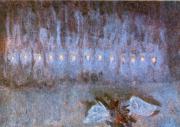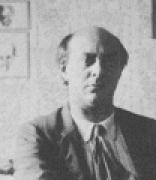Fin de Siècle
Arnold Schönberg: Die glückliche Hand

Image a) | 
Image b) |
The storyline of the ultra-modern play with music, Die glückliche Hand (1910-1913), sounds old-fashioned: the artist who is oppressed by life, represented visually by Arnold Schönberg(1874 Vienna - 1951 Los Angeles) easily masters his goals with visionary atmosphere. Darkness is represented musicaöy by atonality. Using many repetitions of short themes - patterns which move in the background - and the correlation of lighting and musical timbre, (Example: the beginning of the play). Schönberg's stage directions are evidence that he was acquainted with the movies; his designs for the sets show his desire to expand his means of expression. (Example a: The set design for scene 1 of the Glücklichen Hand with the glowing eyes of the men and women) Obviously Schönberg (Illustration b, Schönberg as a young man) was looking for alternatives - perhaps even better-paid career chances. (M. Saary)
|
© Sound: 1981 SONY CLASSICAL SMK 48 464, Interpreten: BBC Singers, BBC Symphony Orchestra, Pierre Boulez (Leitung).
Links to other albums:
|




